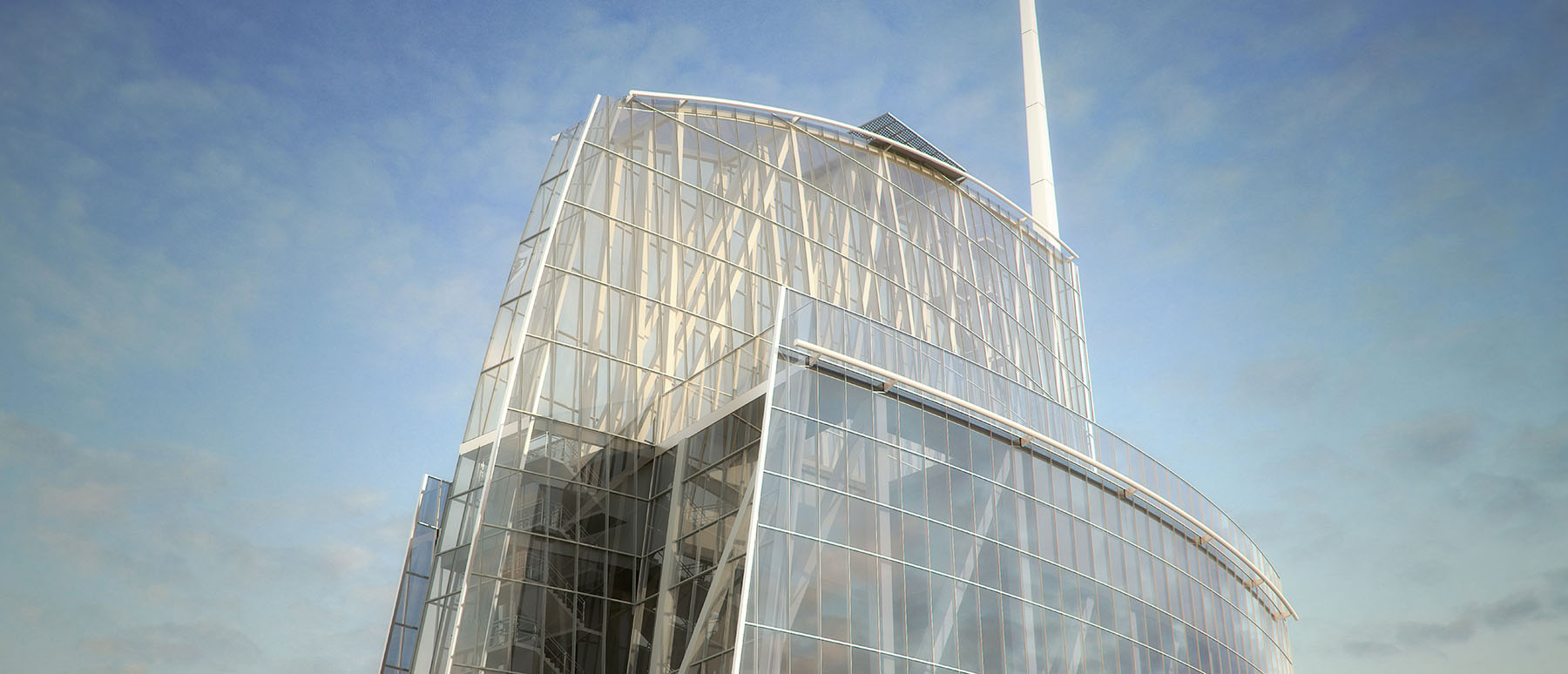The façade of a building defines both its mark in a landscape and its footprint on the environment. And that’s definitely apparent with the new Wilshire Grand in downtown Los Angeles. Designed by AC Martin, Wilshire Grand Tower is a wholly unique entry into the LA skyline, and has reshaped what a high-rise can look like in Southern California.
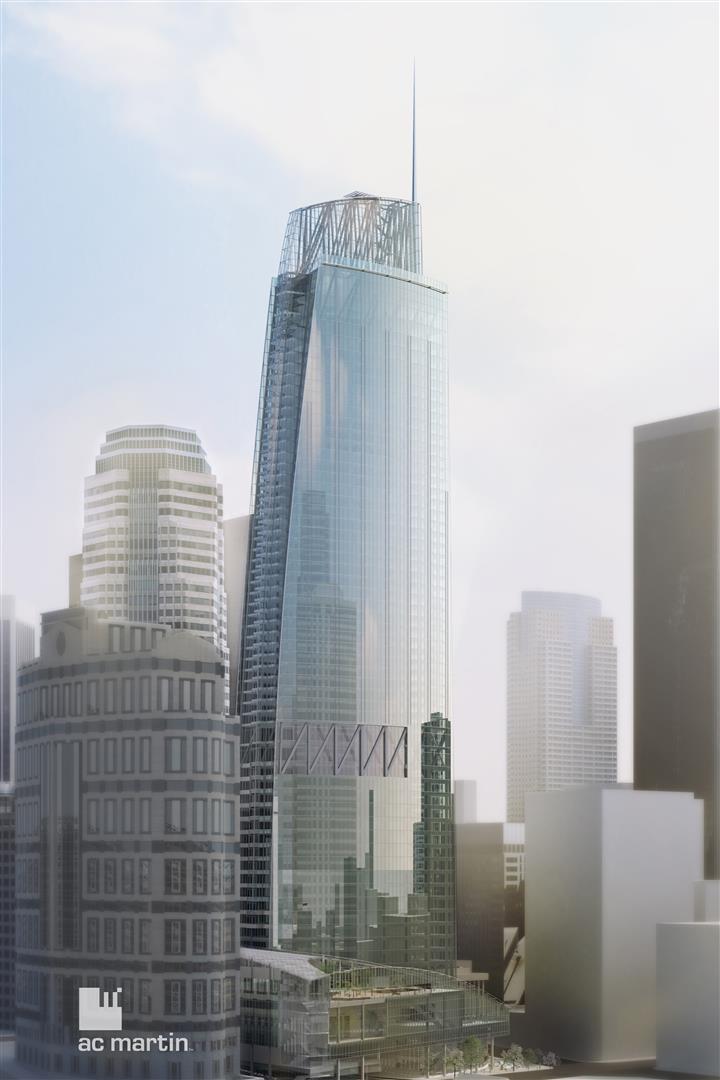
Design decisions surrounding the amount of vision glass, glazing specification, window assembly, wall insulation, and shading devices have a significant effect on a building’s overall appearance and performance. With so many variables in play, a collaborative effort between all disciplines is required for a building’s facade to meet both the aesthetic and sustainability goals. The optimal strategy is different for every building depending on the geometry, orientation, location, and occupancy type. When properly designed, the facade can help reduce the energy usage for air conditioning, provide ample natural daylight and create a comfortable environment for all its occupants. In order to find the medium between these parameters for the Wilshire Grand, numerous iterations of the building envelope were analyzed by the team.
The original building envelope concept aimed to provide the best possible view of the Los Angeles landscape for its tenants through maximizing the amount of vision glass. However, there can be a significant downside to maximizing vision glass on the HVAC systems. The original building targeted an 80% window-to-wall ratio (WWR), which was also significantly higher than the Title 24 maximum of 40%. In order to find a balance between building the amount of vision glass and HVAC performance the project team created an energy modeled the building and assessed various WWR options. This helped to establish a WWR of 50% and paved the way towards developing an effective overall energy efficiency strategy for the Wilshire Grand to perform above and beyond California code baseline.
Being in the center of downtown Los Angeles, the team first assessed the site location to determine which parts of the building were shaded at what times in times of the day from neighboring buildings. Based on the shade cast upon the façade by neighboring buildings, a concept was developed for varying the depth of the horizontal and vertical fins along the south façade of the building, thereby maximizing shading potential and minimizing material costs. The envelope study also included the assessment of various glazing specification, insulation values and shading schemes for the Wilshire Grand. This paper aims to serve as a case study for how the design teams can approach the design of facades for tall buildings of the future.
Background of the Wilshire Grand Tower
The Hotel Statler opened in 1952 on the current site of the new Wilshire Grand and became a landmark of downtown Los Angeles during its 50+ year lifespan [1]. The property was purchased in 1989 by Korean Air and in 2012 began demolition of the original hotel in order to make way for what will be the new Wilshire Grand. The new building will top out at 1,099 feet (335 m) and will be the tallest building west of the Mississippi River. As a mixed-use project it will feature retail, commercial office space, restaurant space, nightlife areas and a 900-key hotel. The building had the initial design intent to create an all glass façade that, once finished, would be an iconic and wholly unique addition to the Los Angeles skyline. It was immediately clear that in order for a project of this magnitude to become reality, it would take a group effort. Inter-disciple cooperation between the architects, façade engineers, and the MEP engineering team would be critical to success.
The primary objective of the envelope study was two-fold: first, find the optimal window-to-wall ratio and second, tune the envelope parameters to improve the building’s energy performance. Ultimately, it was desired for the project to both maximize window-to-wall ratio and ensure the building’s facade was extremely energy efficient. It was equally important for the owners and design team maximize view and make as grand an impact as possible on the Los Angeles skyline while maintaining the high sustainability and energy efficiency goals established for the project.
Sustainable Building Design
In order to quantify the effect each design decision had on Wilshire Grand’s envelope performance, Glumac developed multiple iterations of energy models and shading studies throughout the design process. This initially took place in the conceptual phase, where insights to the envelope performance could be most impactful on the façade design. This analysis continued throughout the entire design process with close collaboration between AC Martin and their design consultants. The following section outlines the process used to reach the final façade design for the Wilshire Grand.
Method – Solar Radiation – Site
Due to the density of the Financial District in downtown LA, a shading study was imperative to determine how other high-rise buildings in the area would affect the façade of Wilshire Grand. Using a conceptual massing model of the building, the shading effect from adjacent buildings at various times of the year was determined (specifically, the mornings and evenings of both the equinox and solstice) as shown in Figures 2-5. This study utilized Autodesk’s Ecotect Analysis software engine.

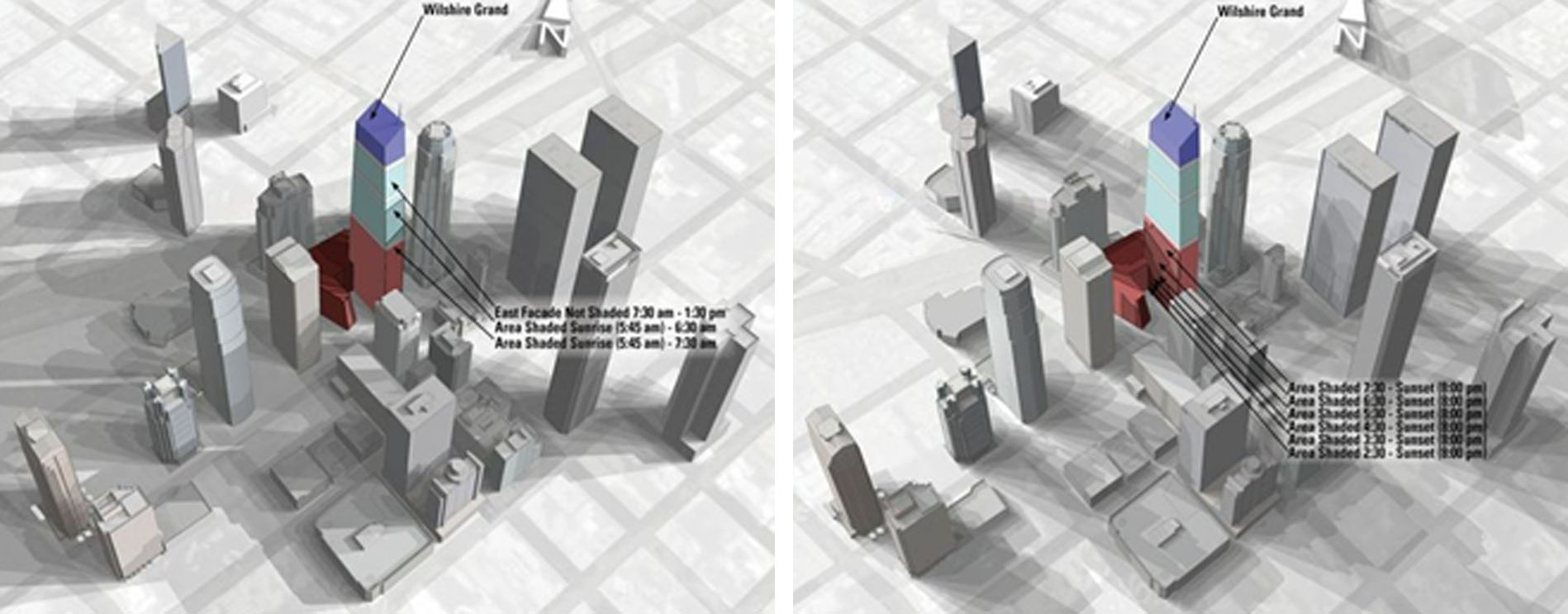
These studies illustrated the extreme sun angles throughout the year and informed the team how a unique pattern of glass type and shading devices can be designed to create a visually interesting, cost-effective, and high-performance envelope. Portions of the façade that receive more direct solar insolation can potentially be designed with more shading or lower SHGC. For instance, the podium of the building receives the least amount of sunlight and therefore could have a clearer, less-glazed window.
Method: Window-to-Wall Ratio
After establishing the impacts of shading from neighboring building and determining which parts of the building would be most affected by solar heat gains, a simplified energy model was created based on hand sketches from AC Martin. Figure 6 shows initial concept sketches for the building. The original building skin concepts developed included a visible glazing percentage of roughly 80% of the building’s facade.
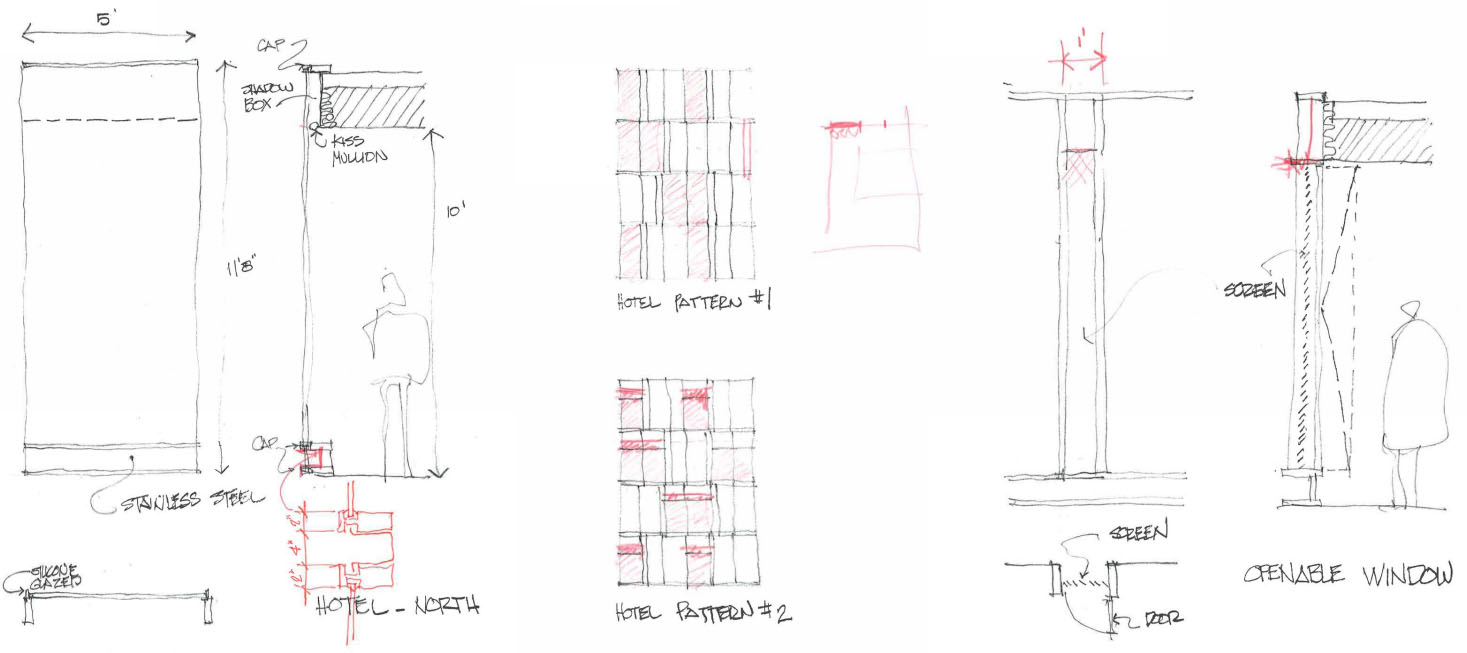
California’s state energy code specifies a maximum window-to-wall ratio (WWR) of 40%. A WWR greater than the maximum must be compensated for through other energy efficiency measures, typically more expensive methods. The project team performed a WWR study by creating three simple energy models of the building, each with a WWR of 50%, 55%, and 60%. The energy modeling software eQUEST was used to estimate the total annual energy lost through the building envelope for each model, which was compared to the baseline Title-24 code design. The results of this analysis determined what WWR was the right balance of aesthetics and energy performance.
Method – Glazing
In order to analyze the effect of the glazing type on the performance of the envelope, a more sophisticated model was built in eQUEST, which incorporated the mechanical systems, occupancy and other energy-consuming aspects of the building. Creating an eQUEST model using the architectural Revit geometry ensured that the energy model fully captured all physical details and space programming. Images from this eQUEST study is shown in Figures 7 & 8. The energy model also gained insight into the building envelope’s effect on energy usage, sizing of MEP systems and perceived comfort level of occupants. The project team assigned the model a WWR of 50%, R-16 spandrel insulation, and no shading devices.

Multiple Viracon products were chosen as possible candidates for the north and non-north windows of the building, with varying Solar Heat Gain Coefficients (SHGC), visible transmittances, and U-values. These glass products were assessed in the Wilshire Grand’s energy model, which provided an estimate to the annual electricity and natural gas consumption for each option. Translating the estimated energy savings into an annual energy cost, the financial impacts for selecting glazing was determined and compared to the baseline code model.
Method – Shading Devices
The method for assessing exterior shading devices utilized the Ecotect software to determine how much solar radiation could be mitigated from entering the building. The shading scheme was focused on the south façade of the building, which will receive the majority of direct sunlight throughout the year. Figures 9 & 10 show the pattern of solar radiation on the Wilshire Grand’s south façade with no shading devices to serve as a baseline comparison. The color scale represents the total amount of direct solar radiation received with yellow being the highest, red being a medium amount and blue representing the lowest areas.
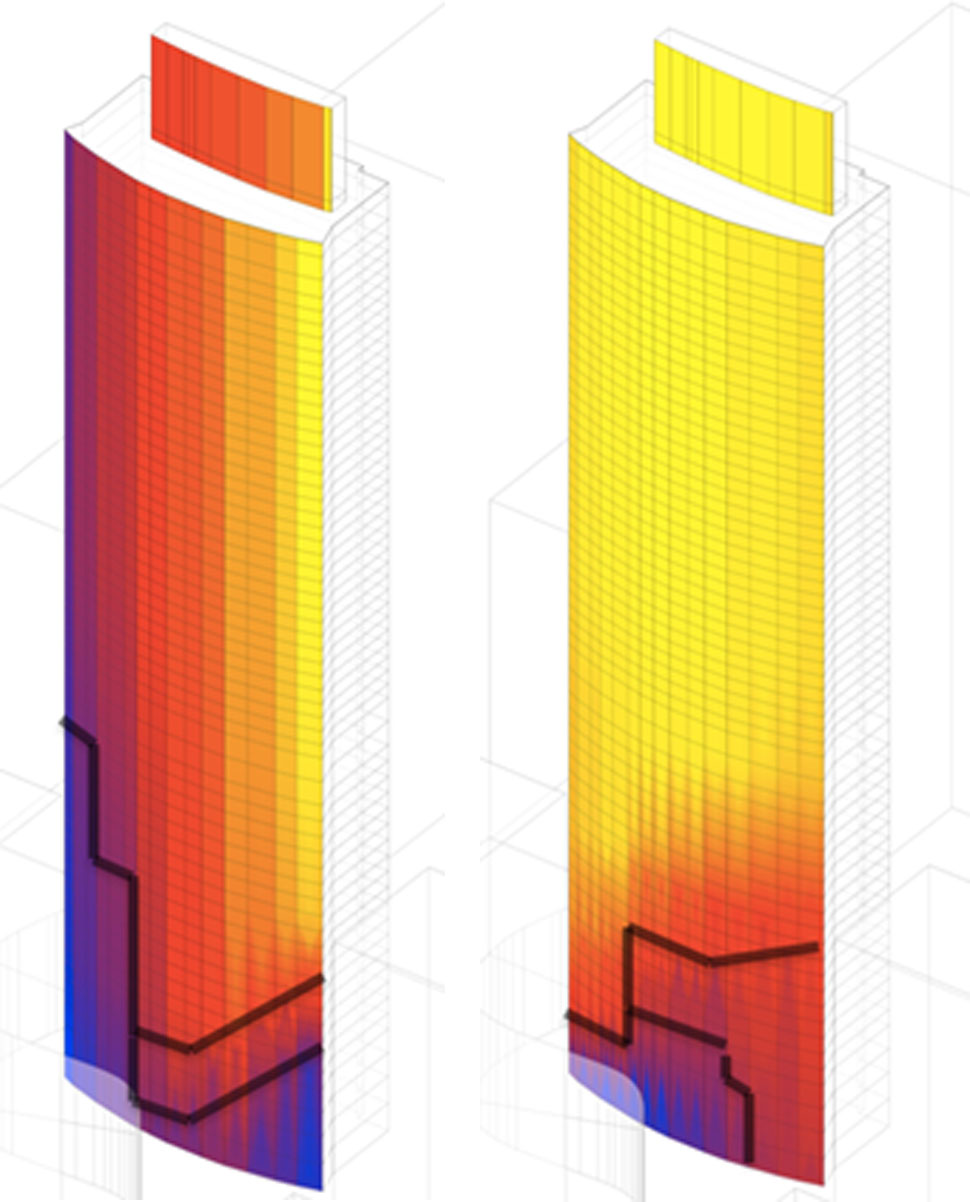
Using this knowledge various iterations for both horizontal and vertical shading were assessed, including uniform fin depth as well as varying depth. The depth of the horizontal and vertical fins along the south façade of the building was considered in effort to map the pattern of the shade cast upon the façade by neighboring buildings, thereby maximizing shading potential and minimizing material costs. Another option considered was recessing the windows by 8 inches from the spandrel, which effectively creates 8-inch fins on all sides of the window but without the added fin material costs.
Data-Driven Design
The data and insights gained through energy modeling helped the team to make informed decisions about the envelope design, which ultimately resulted in a more energy-efficient building, helping the owner’s bottom line with reduced energy costs.
Data – Window-to-Wall Ratio
After assessing the MEP systems and the impacts of increased window heights, it was determined that the WWR would ultimately fall within the range of 50-60% and these values should be assessed in an energy model. Table 1 below describes the overall impact on energy usage that a 50%, 55%, and a 60% WWR would have at the Wilshire Grand compared to the code baseline if 40%.

The results showed the 60% window ratio was estimated to increase the overall energy usage of the building by 5.1% and result in an additional $188,737 of energy costs per year. The added energy costs for a higher window to wall ratio ultimately let the design team to settle on a 50% WWR in order to maximize building efficiency and thermal comfort. It was found that this ratio allowed for adequate natural daylight to enter the space, while significantly reducing heat loss and gain through the facade. Using the results of this study it was estimated that an 80% WWR would have resulted in roughly a 10% energy efficiency penalty and $375,000 in additional annual energy costs.
Data – Glazing & Insulation
After establishing a WWR for the building, multiple glaze options were assessed for the Wilshire Grand’s window assemblies. Window types were studied on the on the north side of the building versus the east, south, and west facades based on the results of the shading study. The North side of the building received significantly less solar radiation compared to other facades and therefore could accommodate clearer glass without significantly affecting the HVAC loads. The various iterations tested the effect of varying solar heat gain coefficients (SHGCs) and quantified the estimated energy savings overall. Table 2 and Figure 11 below show the results of the glazing study.


It was determined the SHGC of the window assembly had a significantly impact on the overall building’s performance. Energy efficiency measure 1B (highlighted) showed a savings of 11%. While none of these glazing options were eventually selected, this ultimately led to the design team specifying high performance low-e coating throughout building. In Los Angeles’s climate, the heat gain from the sun can have a dramatic impact on the HVAC loads and therefore should be more aggressively mitigated. The south/north sides of the tower were specified with VRE 1-38 (SHGC – 0.23, VLT – 36%) and the east/west sides of the building were specified with VNE 13-63 (SHGC – 0.29, VLT – 66%). The shading studies led the team to specify the lowest SHGC on the south side. While the north side of the building did not benefit as much from energy savings, this glass maintained the desired consistent look for the building. The east/west side glazing selection was also better than code baseline and allowed for visible light to pass through. VNE 13-63 was also used for the storefront at the base of the building, a significant improvement compared to standard monolith glass. This variation in glazing patterns at the Wilshire Grand can be seen in Figure 12.

Ultimately the results of the glazing and shading studies resulted in four different glass types to be specified on various parts of the building. These selections all balanced reflectivity, visible light transmittance, and solar heat gain specifically for the location they would be used on the building. Low-e vision glass was chosen to cover the bulk of the tower to mitigate solar heat gain and a frosted insulated laminating glass runs up the spine of the tower to provide an eye catching architectural detail. A third glazing was selected for 10,000-square-feet sweeping atrium skylight to ensure a comfortable environment for occupants and ensure there is a clear view of the tower above. The porte corchere underneath the podium, which will receive virtually no direct sunlight, will have monolithic glass to accentual the grand entrance to the building. The combination of glazing specifications created a high-performing envelope that exceed energy efficiency targets and enhanced the architectural design. This was only possible through results gained from energy modeling and the direct collaboration of owners, architects and energy consultants.
Data – Exterior Shading
Various exterior shading features were analyzed at the Wilshire Grand Tower using the Autodesk’s Ecotect software. This study was focused on the south façade as this side of the building received the most solar radiation. This studied included combination of differing sizes of varying shades (VARY), horizontal and vertical (H&V) shades and recessed windows. An example of the results of one of the shading studies (14” fins) is shown in Figures 13 & 14. The fins were found to be fairly effective at mitigating the solar gain and additionally would provide benefits for glare. The color scale represents the total amount of direct solar radiation received with yellow being the highest, red being a medium amount and blue representing the lowest areas.


Using this information, it was determined how much these shading devices could reduce the overall annual energy costs of the building, as shown in Figure 15. While 18” vertical and horizontal shades on the south façade could reduce the overall energy cost by roughly $120,000, this was not pursued due to the architectural effect of breaking up the all glass façade and additional first cost.

Data – HVAC
An efficient envelope works even better if paired in tandem with an efficient HVAC design. The HVAC design incorporates hydronic built-up air handling units with hydronic reheat for the podium and office levels, broken up floor-by-floor. The hotel guestrooms and support areas are supported by four pipe fan coil units, which corridors and ventilation air provided by hydronic dedicated outside air systems. The ground floor lobby and sky lobbies utilize radiant floor heating/cooling to efficiency create a comfortable environment. The central plant includes high efficiency chillers and condensing boilers to provided chilled and hot water to the entire building. Additionally, a stratified chilled water thermal energy storage tank was utilized to reduce the demand charges and to provide a peak shedding strategy.
Explanation
The solar, window-to-wall ratio, glazing, and shading studies led to an optimized façade design with significant energy savings, but in order to obtain above and beyond energy savings other energy efficiency measures needed to be implemented. By breaking up energy use into its respective end use components one can easily see which energy efficiency measures have the most dramatic effect on the overall energy use and can then drive the conversation to an integrated building design. Each energy efficiency measures end use breakdown was analyzed in comparison to the code baseline. The conclusion of this envelope study culminated in a report that broke apart the price and efficiency of each energy efficiency measure and façade decision. Relative to an ASHRAE 90.1 2007 Baseline the Wilshire Grand is estimated to save $896,428 annually on energy costs, a 24.2% overall energy costs savings. This savings could not have been achieved without the building’s high performance façade design.
Conclusion and Future Work
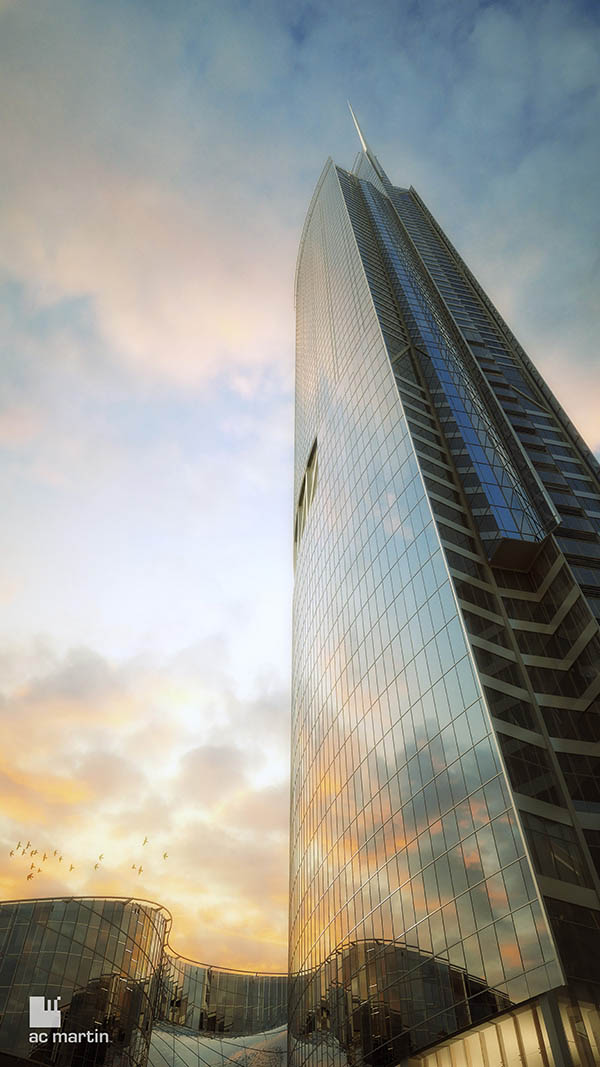
In studying the energy performance of the Wilshire Grand, the design team was able to create a dynamic envelope that successfully intertwines energy efficiency and aesthetic design. There is no doubt about the impact this building will have on downtown Los Angeles’s image, but that does not mean that it must make a sizable impact on the environment. The success of the Wilshire Grand was driven by the entire design team to working together and making informed design decisions from modeled and historical data. This process allowed the team to make compromises that balanced function, financials, performance, and aesthetics.
The design and construction industries are constantly coming up with new and innovative technologies to increase efficiency, drive down cost, and enhance the occupant experience in the built environment. As design trends move towards all glass buildings, smart design and construction, processes need to be implemented. Analyzing the energy model from an early stage allowed the architects and engineers to compromise on a total building solution and allow for innovative technologies to be implemented, thereby capturing maximum energy savings and allowing for a better design.
This project also raises some important questions for the design of future high rise buildings in California. Is it possible with today’s technology to have an energy-efficient (let alone code compliant) 100% glass façade? How should larger views and more natural daylighting be prioritized relative to increasing energy efficiency and thermal comfort? Do high rises fit in the future plan of net zero energy in California? The answers lie in the ability for all stakeholders to work together, which includes building occupants and policy makers. There is a need to work together as the state moves towards its net zero energy goals and rely on modeled and historical data to drive these code changes. Due to its scale, grandeur, and notoriety, Wilshire Grand will be used and an example to influence large-scale construction projects to come in the future.

